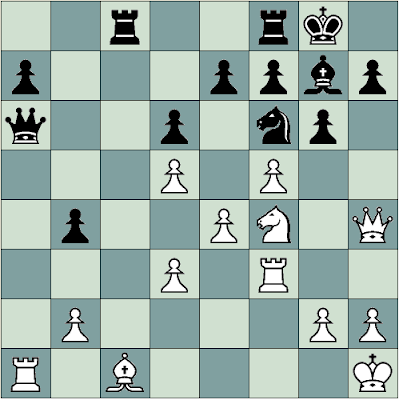The first game involves GM Nick De Firmian, the author of the most recent Modern Chess Openings (MCO) editions. Here he in fact blunders very shortly after theory has ended. The game started as a Pirc Defense, Austrian Attack, and gave rise to this position after 17. ...Bxf3 (D):

White to move
Here De Firmian responded with the natural-looking 18. Rxf3??, only to be confronted with the very brutal 18. ...Qa6!! (D)

He is losing the Rook due to back-rank problems. After 18 moves his c1-bishop is still undeveloped, and it proves decisive here. If he were to play 19. Rb1, Black has 19. ...Qa2 and the Rook is still a goner. The point of 18. ...Qa6 of course is 19. Rxa6 Rxc1+, followed by mate.
The game ended with 19. Be3 Qxa1+ 20. Bg1 Rc1 21. Nh3 Rf1 22. fxg6 hxg6 0-1.
The second game is from a very appreciated player these days, Magnus Carlsen. It's a blitz game played in 2006. This game will maybe be the object of a later endgame analysis here, but for now, let's just look at the very end of the game, where the endgame has simplified greatly:
Carlsen, M. (2675) - Gagunashvili, M. (2591)
White to move
This position is a draw. White played 64. Rxh5, which was rather forced, and Black responded with 64. ...Kxf3 (D):

This position is now more than ever obviously draw, because White has to give up his pawn in order to defend against the mating threat. Or does he? Carlsen played 65. e5??, and got immediately mated with 65. ...Rc1#.
The third game involves amateurs -- but strong players nonetheless. It was played in 2002, and reached an ending too. The endgame was completely won for White, but he messed up... twice. The position after 70. ...d2 (D):
Da Silva, J. (2064) - Singh, R. (2133p)

White to move
Here White threw away the win with 71. Rxc3?? (71. Rxd2+!) 71. ...Kxc3 72. Rxd2. I suspect White missed the following in his calculations: 72. ...Re8+ (D):

0-1 -- White resigned. Up to then I was thinking to myself, what a blunder, he was completely winning and he lost this game. I showed this game to my brother (who has approximately the same rating as I do), to show him the blunder on move 71, and he eventually told me "I don't understand why he resigned". And then it hit me -- the final position is a draw. It seems obvious at first sight that White is lost, but mere calculation would have saved this amateur at least a draw. The most obvious continuation (from the last diagram above) is 73. Kf4 Kxd2 74. Kf5 Rg8 75. Kg6 =.
Do you understand now what I meant when I said White blundered twice in this game? The second blunder was to resign!
